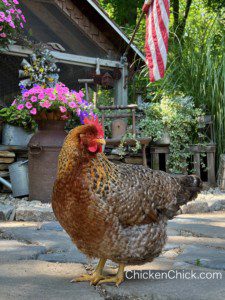
Bielefelder hen.
The sweetest hen in the flock sits in the same nest box all day, growling, puffing out her feathers, even pecking at intruders. She is not a beast to be trifled with. What’s her problem? She is broody, which means she is inspired to hatch chicks, but if she is not actually going to hatch chicks, the behavior must be interrupted, (aka: broken up) promptly.
WHAT’S A BROODY HEN & WHAT CAUSES BROODINESS?
A broody hen is one that is inspired to sit on a nest until she hatches chicks. It is an instinct influenced primarily by hormones and heredity.
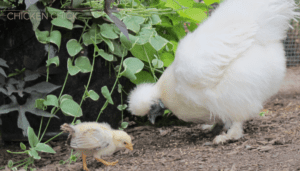
A hen has a hormone surge prior to egg-laying that causes her to find and prepare a nest for the arrival. The hormones usually return to normal levels after the egg is laid, but occasionally they will remain elevated, which causes the hen to sit in a chosen location to hatch eggs. The presence or absence of a rooster in the flock or availability fertilized eggs has absolutely no bearing on broodiness. Some breeds are more predisposed to broodiness than others, Silkies, Orpingtons, and Cochins, for example. I like to say that broodiness is a ‘calling.’ Not every hen will “go broody” in her lifetime, but those that do are committed to their calling and fiercely protective of their territory.
Left to her own devices, a broody hen will lay a clutch of eggs and sit on them, warming them until they hatch (if they were fertilized by a rooster, of course). When she is ready to begin sitting on the eggs, her body releases the hormone prolactin, which temporarily stops ovulation (egg-laying). If all goes according to plan, 21 days later, chicks hatch, she raise her chicks and resumes egg-laying approximately 6 weeks later.
A broody hen does not have a 3 week timer that alerts her to leave the nest after 3 weeks. Broodiness can continue long beyond three weeks, resulting in negative health consequences to the hen and problems for the flock.
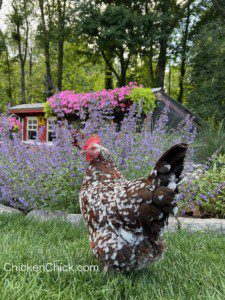
A hen cannot be induced to brood, nor will taking eggs away from her discourage brooding.
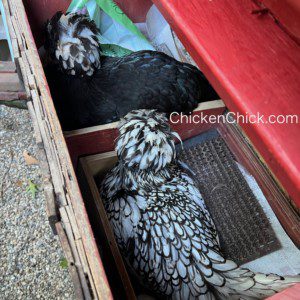
HOW TO IDENTIFY A BROODY HEN
Since chickens are prey animals, a broody prefers a dark, private location to sit as she will be vulnerable while doing so . Her chosen spot may be a nest box or a hidden location away from the coop. It is not unheard of for a hen to disappear from the flock and return three weeks later with baby chicks in tow.

Freida, a Silkie hen with her chick.
The sweetest hen in a flock is barely recognizable when she is broody. She is fiercely protective of her territory. When approached, she growls, shrieks, puffs out her feathers, and pecks at any intruder, trying to be as intimidating as possible in defense of her eggs.
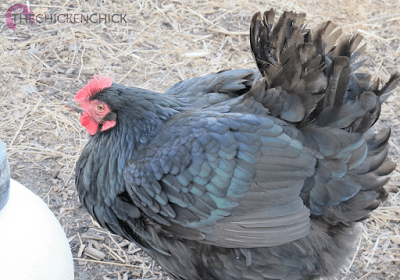
This Marans hen is exhibiting typical feather fluffing in an effort to be intimidating to perceived predators.
A broody hen sits in her chosen spot, briefly leaving it once or twice a day to eat, drink and relieve herself. Broody poop is the most horrendous-looking, foul-smelling and ginormous of all specimens because the droppings are retained for hours versus being eliminated regularly throughout the day. A broody hen does not foul her nest, keeping it clean for her anticipated chicks.
A broody plucks her own breast feathers to expose the warmth and moisture of her skin directly to the eggs. hence the expression “to feather one’s nest.”

THE CONSEQUENCES OF UNWANTED BROODINESS
Her calling requires her to sit and wait for chicks to hatch. The lack of fertile eggs or any eggs at all do not concern her. She obeys her calling to sit and in doing so, she will neglect herself for the good of her anticipated chicks. She eat, drinks and eliminates waste once or twice a day, at most. She will eat approximately 80% less feed and water daily, resulting in malnutrition and dehydration. Her comb becomes pale, her feathers lose sheen and she loses a noticeable amount of weight. This drastic change normal routine is tolerable in 21 day stints but protracted stints are unhealthy for her.
She will continue to lose weight and becomes vulnerable to external parasites. She stops producing eggs while brooding and for five weeks or longer thereafter. She cannot be relied upon for contributions to egg sales or consumption for eight weeks total, on average.
Broodiness begets broodiness. Her behavior often inspires other hens in the flock to brood, multiplying the consequences already mentioned. A broody occupies a nest box that laying hens may wish to use; they may peck and injure her to chase her off or join her in the nest, creating an environment in which eggs can be broken, or may find another, less desirable place to lay eggs.
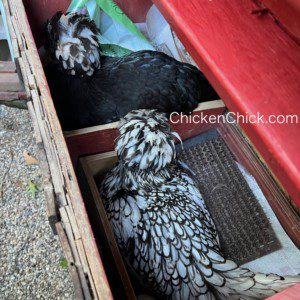
HOW TO BREAK A BROODY
A broody hen who is allowed to sit indefinitely can suffer long-term health consequences and even die from malnutrition or dehydration. It is important to ‘break’ or stop a hen’s broodiness as soon as possible after identifying the behavior. The longer she is broody, the longer it will take to break her and the longer it will take for her to return to egg-laying. If the behavior is identified within the first day or two, it can often be reversed within a day or two. To break a broody, her belly must be cooled off gradually and her comfy nesting routine disrupted in a deliberate method I call “the broody breaker.”
There are many suggested methods for broody-breaking, some unreliable or ineffective, some cruel and inhumane. I strongly recommend against any technique involving water or ice. I also do not recommend the ‘boomerang’ method of repeatedly ejecting her from the nest, only for her to panic, cluck and run directly back to her chosen spot or to sit right down in protest before running back to her nest. I find this method unnecessarily protracted and stressful for everyone.
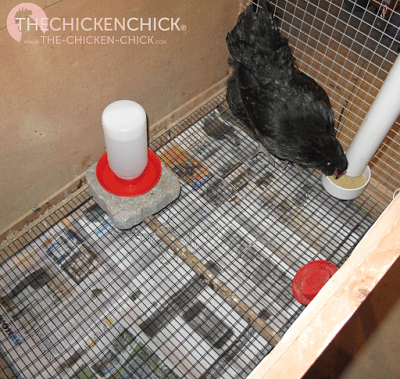
THE BROODY BREAKER
To break a broody hen, I use a proven and reliable method consisting of a wire-bottomed cage, raised off the floor, placed in a well-lit location away from the coop. As soon as a broody is identified, she goes into the Broody Breaker. A rabbit hutch serves this purpose perfectly. Water can be offered conveniently in a chick nipple drinker and feed can be attached to the sides in cage cup
The wire bottomed cage allows cooler air to circulate under the hen, cooling off her brood patch on her abdomen. The key is an elevated, wire bottomed cage without litter, located away from the coop. She is kept in the Broody Breaker 24 hours a day until she is no longer broody, aka: “broken up.”
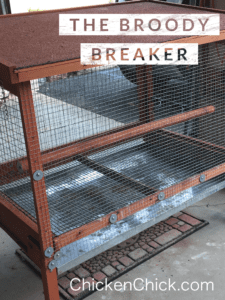
My Broody Breaker is a modified rabbit hutch that I keep in the garage, which is a bright, busy location.
A second method of breaking up a broody is to graft chicks to her, which can be risky. Learn how to graft chicks to a broody hen here.
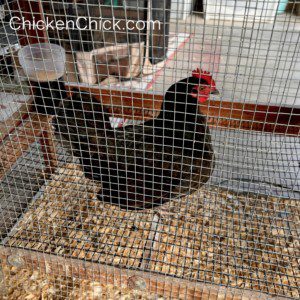
Cleopatra in Cell Block B
Once in the Broody Breaker, she may be upset briefly but should soon settle down. A broody hen prefers a dark, secluded, private location perceived as safe for an extended stay. The Broody Breaker creates the opposite environment preferred by the broody hen.
If she is identified early in her broody state, she should be broken within a few days and back to egg laying within a week or so. The longer she is allowed to sit, the longer she will have to remain in the Broody Breaker and the longer she will take to get back to egg production.
HOW TO KNOW WHEN SHE’S BROKEN UP?
When a broody hen begins walking around the cage, eating, drinking and pooping frequently throughout the day, she may be broken up and ready to return to the coop. To test whether a hen is ready to join the flock as a contributing member again, remove her from the Broody Breaker and watch her behavior. If she is still broody she will high-tail it directly back to her chosen nest soon, in which case, back she goes into the Broody Breaker until she begins behaving normally again. If the flock exhibits hostility towards the returning hen, use the Playpen Method described here to reintegrate her into the flock.

Kathy Shea Mormino
Affectionately known internationally as The Chicken Chick®, Kathy Shea Mormino shares a fun-loving, informative style to raising backyard chickens. …Read on


shop my SPONSORS

Bielefelder hen.
The sweetest hen in the flock sits in the same nest box all day, growling, puffing out her feathers, even pecking at intruders. She is not a beast to be trifled with. What’s her problem? She is broody, which means she is inspired to hatch chicks, but if she is not actually going to hatch chicks, the behavior must be interrupted, (aka: broken up) promptly.
WHAT’S A BROODY HEN & WHAT CAUSES BROODINESS?
A broody hen is one that is inspired to sit on a nest until she hatches chicks. It is an instinct influenced primarily by hormones and heredity.

A hen has a hormone surge prior to egg-laying that causes her to find and prepare a nest for the arrival. The hormones usually return to normal levels after the egg is laid, but occasionally they will remain elevated, which causes the hen to sit in a chosen location to hatch eggs. The presence or absence of a rooster in the flock or availability fertilized eggs has absolutely no bearing on broodiness. Some breeds are more predisposed to broodiness than others, Silkies, Orpingtons, and Cochins, for example. I like to say that broodiness is a ‘calling.’ Not every hen will “go broody” in her lifetime, but those that do are committed to their calling and fiercely protective of their territory.
Left to her own devices, a broody hen will lay a clutch of eggs and sit on them, warming them until they hatch (if they were fertilized by a rooster, of course). When she is ready to begin sitting on the eggs, her body releases the hormone prolactin, which temporarily stops ovulation (egg-laying). If all goes according to plan, 21 days later, chicks hatch, she raise her chicks and resumes egg-laying approximately 6 weeks later.
A broody hen does not have a 3 week timer that alerts her to leave the nest after 3 weeks. Broodiness can continue long beyond three weeks, resulting in negative health consequences to the hen and problems for the flock.

A hen cannot be induced to brood, nor will taking eggs away from her discourage brooding.

HOW TO IDENTIFY A BROODY HEN
Since chickens are prey animals, a broody prefers a dark, private location to sit as she will be vulnerable while doing so . Her chosen spot may be a nest box or a hidden location away from the coop. It is not unheard of for a hen to disappear from the flock and return three weeks later with baby chicks in tow.

Freida, a Silkie hen with her chick.
The sweetest hen in a flock is barely recognizable when she is broody. She is fiercely protective of her territory. When approached, she growls, shrieks, puffs out her feathers, and pecks at any intruder, trying to be as intimidating as possible in defense of her eggs.

This Marans hen is exhibiting typical feather fluffing in an effort to be intimidating to perceived predators.
A broody hen sits in her chosen spot, briefly leaving it once or twice a day to eat, drink and relieve herself. Broody poop is the most horrendous-looking, foul-smelling and ginormous of all specimens because the droppings are retained for hours versus being eliminated regularly throughout the day. A broody hen does not foul her nest, keeping it clean for her anticipated chicks.
A broody plucks her own breast feathers to expose the warmth and moisture of her skin directly to the eggs. hence the expression “to feather one’s nest.”

THE CONSEQUENCES OF UNWANTED BROODINESS
Her calling requires her to sit and wait for chicks to hatch. The lack of fertile eggs or any eggs at all do not concern her. She obeys her calling to sit and in doing so, she will neglect herself for the good of her anticipated chicks. She eat, drinks and eliminates waste once or twice a day, at most. She will eat approximately 80% less feed and water daily, resulting in malnutrition and dehydration. Her comb becomes pale, her feathers lose sheen and she loses a noticeable amount of weight. This drastic change normal routine is tolerable in 21 day stints but protracted stints are unhealthy for her.
She will continue to lose weight and becomes vulnerable to external parasites. She stops producing eggs while brooding and for five weeks or longer thereafter. She cannot be relied upon for contributions to egg sales or consumption for eight weeks total, on average.
Broodiness begets broodiness. Her behavior often inspires other hens in the flock to brood, multiplying the consequences already mentioned. A broody occupies a nest box that laying hens may wish to use; they may peck and injure her to chase her off or join her in the nest, creating an environment in which eggs can be broken, or may find another, less desirable place to lay eggs.

HOW TO BREAK A BROODY
A broody hen who is allowed to sit indefinitely can suffer long-term health consequences and even die from malnutrition or dehydration. It is important to ‘break’ or stop a hen’s broodiness as soon as possible after identifying the behavior. The longer she is broody, the longer it will take to break her and the longer it will take for her to return to egg-laying. If the behavior is identified within the first day or two, it can often be reversed within a day or two. To break a broody, her belly must be cooled off gradually and her comfy nesting routine disrupted in a deliberate method I call “the broody breaker.”
There are many suggested methods for broody-breaking, some unreliable or ineffective, some cruel and inhumane. I strongly recommend against any technique involving water or ice. I also do not recommend the ‘boomerang’ method of repeatedly ejecting her from the nest, only for her to panic, cluck and run directly back to her chosen spot or to sit right down in protest before running back to her nest. I find this method unnecessarily protracted and stressful for everyone.

THE BROODY BREAKER
To break a broody hen, I use a proven and reliable method consisting of a wire-bottomed cage, raised off the floor, placed in a well-lit location away from the coop. As soon as a broody is identified, she goes into the Broody Breaker. A rabbit hutch serves this purpose perfectly. Water can be offered conveniently in a chick nipple drinker and feed can be attached to the sides in cage cup
The wire bottomed cage allows cooler air to circulate under the hen, cooling off her brood patch on her abdomen. The key is an elevated, wire bottomed cage without litter, located away from the coop. She is kept in the Broody Breaker 24 hours a day until she is no longer broody, aka: “broken up.”

My Broody Breaker is a modified rabbit hutch that I keep in the garage, which is a bright, busy location.
A second method of breaking up a broody is to graft chicks to her, which can be risky. Learn how to graft chicks to a broody hen here.

Cleopatra in Cell Block B
Once in the Broody Breaker, she may be upset briefly but should soon settle down. A broody hen prefers a dark, secluded, private location perceived as safe for an extended stay. The Broody Breaker creates the opposite environment preferred by the broody hen.
If she is identified early in her broody state, she should be broken within a few days and back to egg laying within a week or so. The longer she is allowed to sit, the longer she will have to remain in the Broody Breaker and the longer she will take to get back to egg production.
HOW TO KNOW WHEN SHE’S BROKEN UP?
When a broody hen begins walking around the cage, eating, drinking and pooping frequently throughout the day, she may be broken up and ready to return to the coop. To test whether a hen is ready to join the flock as a contributing member again, remove her from the Broody Breaker and watch her behavior. If she is still broody she will high-tail it directly back to her chosen nest soon, in which case, back she goes into the Broody Breaker until she begins behaving normally again. If the flock exhibits hostility towards the returning hen, use the Playpen Method described here to reintegrate her into the flock.





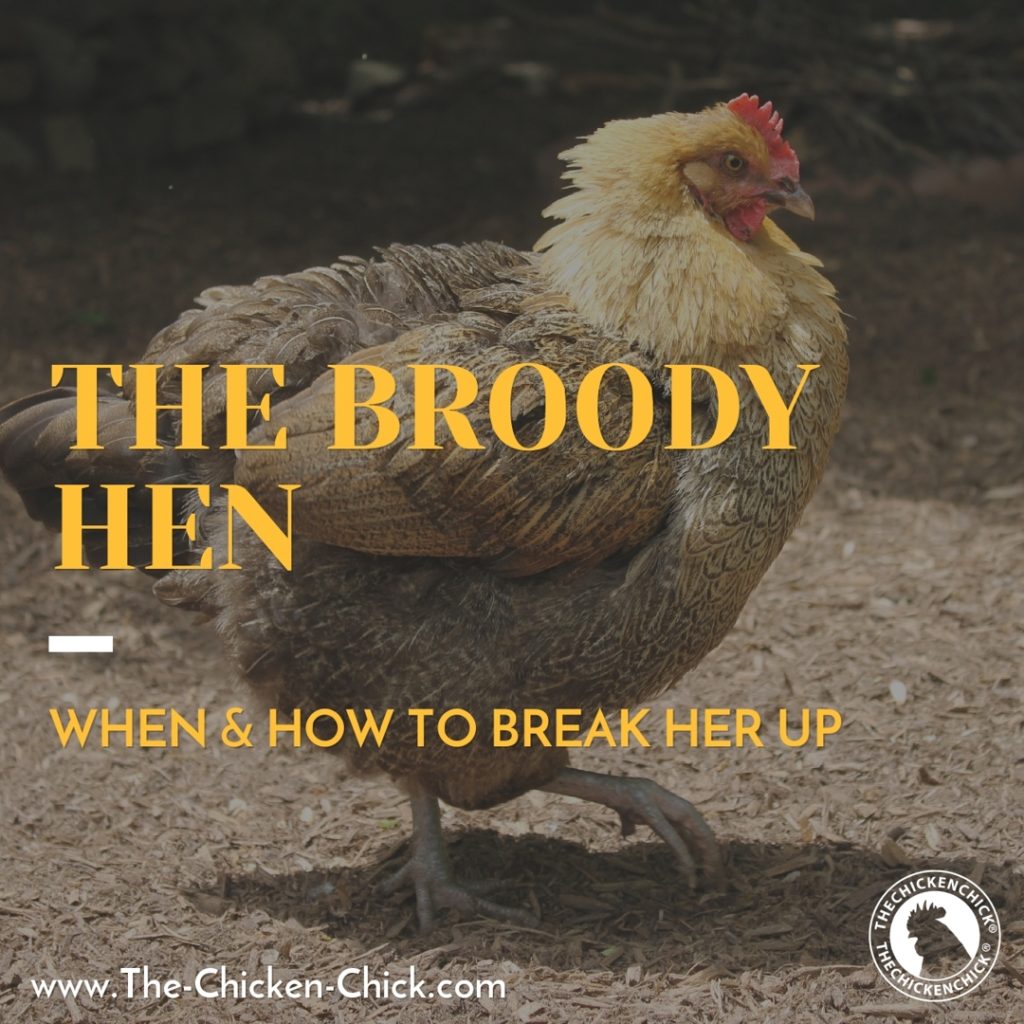



































Lol! I don't read then all, as in I'm on chicken overload! I've had chickens since 11/13. I had one I bought from a breeder died in 2 days from mites. (funny thought, I thought the chicken liked me because I could easily pick it up.) He said "what you never had a chicken die?" I can sneak in and squeeze sevin on them with the duster you displayed. Sour/impacted crops helped me through saving a little guy. He didn't look so good. I picked him up and his crop felt like a water ballon. I thought he might have… Read more »
Oh my God, I'm so glad to tell everyone the real thing that happen to me…My name is EMILIANO BABARAH. If i refuse to share this testimony it means i am selfish to my self and to people i love so much whom might have similar problems, March 16th about something 7:23pm after taken our dinner my husband got crazy started calling a lady name Melisa I love you, i was so mad and started crying like a baby…then my husband left home for the idiot called Melisa, and never return back home then i believed when he uthen nderstand… Read more »
Hi, yes it does! I think the other chick has gone broody again because her friend has been broody for so long! Shall we just let them get on with it? If we brought eggs to rear would we have to put her in seperate house whilst she say on them?
Things were not fair to me when my lover left me for another girl. My name is Tatae from Sweden and there has been a lot of joy in my heart since the very day that Dr.Zabaza whose contact details are via phone number +2348182620374 or via email at: zabaza.logan@yahoo.com came to rescue me from the bondage i was in before. And i still thank the owners of that site on were able to display Dr.Zabaza contact details and address because through the help of Dr.Zabaza a lot of broken home has been restored do contact Dr.Zabaza on the details… Read more »
I need your help. I live in the city limits (no chickens allowed). In December a hen showed up in my backyard. She goes between 4 backyards actually. None of us have a coop (since its against city ordinance). She went "missing" in March for about a week. Then retuned. She went missing again about 10 days ago. We just realized 2 days ago that she is brooding on the ground in my backyard (hidden under a fern). She left the area to eat and I saw there are 14 eggs that she has been sitting on. As far as… Read more »